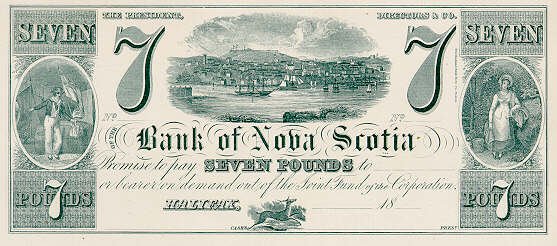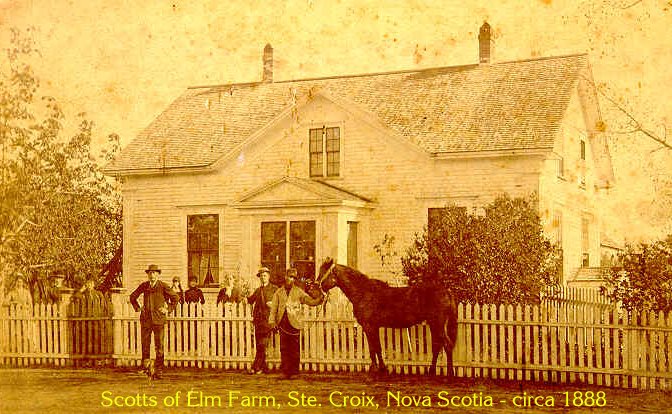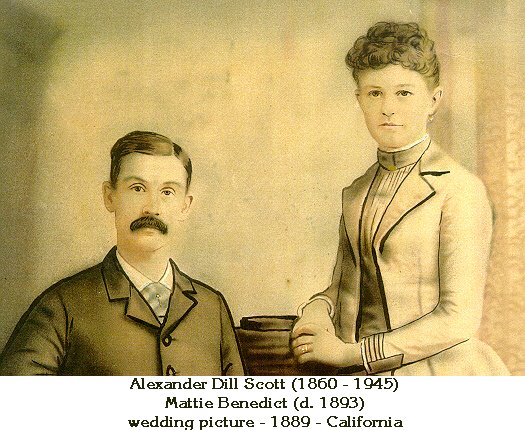| . |
HomePort
|
Alexander Dill Scott (1860-1945) |
| . |
 |
Born at Elm Farm in Nova Scotia, Alexender Dill Scott was the third
child of David Scott and Jane Hunter Dill of Ste Croix. The first
boy, there would eventually be a total of six girls and two boys.
Although one might expect that his middle name came from his mother's family,
and possibly that was a factor, there was another source on his father's
side.
His father, David Scott, had been adopted by his uncle, Alexander Dill and his wife, after David's mother Elizabeth Dill died. With no children of their own the uncle and aunt left their two hundred acre farm to the adopted Scott nephew. The nephew honoured his uncle's memory in naming his first son Alexander Dill Scott. Dill quickly became his nick name, and one he retained throughout his life. The will transferring Elm Farm from Alexander Dill in typical fashion of the day, respected the rights of women to enjoy use of their home but passed land ownership to the younger generation of farmers. Thus David Scott received the farm upon his uncle's death, at age 89 - but only half of the house - his aunt while she was alive had: |
One half of the house. . . namely the west end with the privilege of cooking in the back room also fuel at the door and cut up fit for fire place or stove as my beloved wife may choose I give to my beloved wife a good milk cow: - and the cow to be summered and wintered also three ewes kept as the cow summer and winter . . one quarter of the garden on the west . . . one quarter of the fruit trees.The young Alexander Dill Scott grew up surrounded by the sights and sounds of a busy and prosperous farm. His father although never wealthy, bought and sold land and was an auctioneer, acquiring the moniker of "Squire" - his name was recorded on deeds as David Scott Esq. and he was Justice of the Peace. Local J.P.'s held an important position in rural Nova Scotia during the nineteenth century when government and judicial structures were minimal. A part owner of the Windsor schooner Adonia and a carding mill in Ste Croix, David was a farmer who seemed determined to establish himself in other lines of business. Selling his carding mill interests to Charles Standfield, he eventually would see the Standfield family establish some of the most successful mills in Canada. Later generations would see the Standfield family move into provincial and national politics and continue to operate their multinational textile operations from Truro, Nova Scotia.
Alexander Dill Scott recalled years later in a letter, of the time he
was playing at age five or six in his father's carding mill, when his hand
became "caught in the cogs of the machinery and of course caused a whole
lot of concern for a time." Luckily Dill escaped the industrial accident
without serious damage. Carding mills were not part of the future for either
David or his eldest son, but mercantile trade was.
 |
Packing the family up, when Alexander Dill Scott was thirteen the whole family moved to Halifax, Nova Scotia, the capital of the newly established Canadian province. Purchasing a store on 20 Sackville St. which was near the waterfront, the family in 1873-74 were successors to S.S.B. Smith, Grocer. Renaming the operation after their home village, Ste Croix House was listed as a Commission Merchant Wholesale and Retail in American & West Indian Goods. Located at the foot of Sackville between Lower Water Street and Hollis Street, the area was in the centre of highly competitive trade in the city. |
With eight children in the family, the house and store must have been tight quarters because soon the boarding house next door at 22 Sackville, which had operated by D. Stamper as the Mayflower House, the year they arrived, was listed as the Scott residence.

Eventually Alexander Dill Scott at the age of eighteen was listed separately in city directories, boarding at his family's residence and working as a clerk. It is possible that Dill was employed by his parents in Ste Croix House although employer is not indicated in the directory.
By 1878 the business had run a rough course and refinancing had already tried once to rescue the operation. With three mortgages on his farm properties in Ste Croix, David Scott had to admit that the business he had purchased was not surviving. Although family legends contend an unscrupulous owner, keen to unload a losing business took advantage of him when selling the operation initially, the business had survived and fed a family of ten for half a decade, despite the ever changing nature of retail and wholesale business.

Now with his mill sold, his city store gone and three mortgages to pay, the family relocated to their farm, likely with the remainder of their stock as they quickly opened a business - which was appropriately called Ste Croix House. Situated on the main coach road across from their home, the remains of the foundation stones are now moss covered in a pasture. Mention is made of a previous store on this site as early as 1837, and there may have been some business facility in place when they returned home.
Apparently Dill returned with his family to Ste Croix, where he might
have expected as eldest son to inherit the farm (and its mortgages).
His younger brother John, would eventually fulfil that role but Dill within
three years of their return had other plans. At the age of 22, he
was interested in California and had arranged transportation along with
friends with similar interests, to make the journey. In 1882, Dill along
with the neighbouring Sweet family, made their way to California as a large group. The journey was written up in the local newspaper
A carload of Windsorians for California - a large party of respectable persons, mostly farmer's sons, from near Windsor, Nova Scotia, left here yesterday for the Pacific Coast. The party consists of 14 persons and four children. Their names are as follows . . .
.
Dill headed to Humboldt County where he stayed for two years. Dill had
family living in California including two MacDonald cousins listed in San
Francisco in 1910. Whether there is a connection to these cousin
remains a mystery but we know that Dill went to work at "McDonald brothers
store in 1884" in Novato, California.
Novato would be the key to establishing himself. Taking a course in a business college at some stage he applied his sales clerk experience with his training and bought the store from the owner:
"The name of the post office was Black Point, and after I moved my store which I had bought from the McDonalds, I made application to the government to have the name changed, to Novato, which was done without question. I was postmaster at the time, having succeeded J. B. Redmond, and remained postmaster for, 20 years."Dill being an early resident of the area was thus credited with several firsts including; owning the first store in Novato, naming the community (after a Mexican term used in the area), helping create the first bank in town as one of the original incorporates of the Bank of Novato in 1913. He served as a member of the bank's board of directors and a brief outline of his life is given in a volume entitled, Financing an Empire, History of Banking in California, which was published in 1927.
 |
At the age of twenty-nine Dill was established enough to consider marriage,
and he married Mattie Benedict in 1889. They welcomed the arrival
of a son Alger in 1890, and a daughter Jessie in 1891. The sudden
death of Mattie in 1893 was a tragic loss to the young family and Dill
was unable to care for two young children and run a business at the same
time. With few options he turned to family for help. Although
his parents and family were a continent away on the home farm in Ste Croix,
that was where he turned. There two maiden sisters and his bachelor
brother lived, along with his parents who were in their sixties.
His Nova Scotia family was still recovering from their own tragic loss
after three of Dill's sisters died from Tuberculosis (called Consumption)
between 1889 and 1891. The arrival of young Jessie into the home must have
been a breath of fresh air for the maiden aunts who were both in their
forties and likely knew they might not have children of their own.
|

Elm Farm had already nurtured three generations of his family, would nurture Dill's young daughter Jessie. Leaving her in the care of Annie, Alice, John and his parents, Dill returned to Novato. Jessie a bright and attentive learner quickly discovered books and a home where Annie, a teacher was keen to introduce Jessie to the world of learning. It was not a surprise to her relatives in Ste Croix when Jessie, like her Aunt Annie, embraced teaching as an adult.
Although Jessie would not live in Nova Scotia long her influence would long be felt. A writer of letters and herself unmarried, she forged new links between the growing California clan and the Nova Scotia families which others would follow. When her Nova Scotian nephew John Redford Scott, was unable to finance his university education he received a personal loan from her so he could study for ministry. As an ordained minister working in a mission field in Northern Canada, he would repay Aunt Jessie the money he owed.
While maiden aunts, a bachelor uncle, and her grandparents would help raise young Jessie, she needed a permanent home with her father and brother Alger.
In California, Dill had met a young woman who had become involved in the Christian Science religion, a group founded by Mary Baker Eddy in 1879. Central to Eddy's teaching was the concept of spiritual healing, which led followers to mistrust medical science and avoid medications prescribed for illness. This aspect of the belief would eventually have an impact on family members.
In 1895, despite their religious differences, Dill a lifelong
Presbyterian married Frances Peters and brought Jessie back to California
from Nova Scotia, reuniting her with her brother Alger.
 |
Frances and Dill raised the young family but religion appears to have
divided along gender lines with Frances appealing to both children to adopt
her Christian Science views. Alger appears to have resisted the approach
and followed his father's example in adopting the Presbyterian faith.
Jessie was drawn into the same teachings as her step mother and adopted
the Christian Science principles. While her mother had no major health
problems to contend with, Jessie was not so lucky and developed severe
Arthritis in her twenties. Refusing medical assistance for the painful,
crippling disease she suffered needlessly with her condition.
A school teacher in Santa Ana until her retirement Jessie used a step stool each day to get into her car, as she was too crippled to lift her legs that high. Eventually common sense prevailed and some relief was found from the pain. This meant defying Christian Science teachings, which she eventually did. |
While Jessie never married, Dill and Frances watched the family grow through Alger's children - Alger Jr., Harriet and Royal. While the family grew they would face tragedy with the death of Alger at the age of 48. With two children in school and his oldest son, Alger Jr. training with him in the California petrochemical industry the father and son worked together, living away from home for long periods. For two years Alger was concerned for his failing health, but three doctors in Hanford CA. continued to diagnose his troubles as pernicious anemia a condition known as vitamin B12 deficiency today.
Troubled and in pain he eventually checked into a Fresno hospital, determined to get to the bottom of the matter. Quickly the doctors realized that he was suffering from a serious condition and surgery confirmed that cancer had spread throughout his body starting from the area between the stomach and the spine. He was given 6 to 24 months to live but that was too optimistic. Although he had worked up until the day he walked into the hospital, his body was not strong enough to recover from the surgery. On April 24, 1938 he was dead at 48.

Alger Jr. was 24, Royal was 17 and Harriet was 19. With
a steady job and the younger ones still studying, Alger Jr. knew that he
would have big shoes to fill, and after taking a day off work to attend
the funeral resumed his work, knowing that the family needed his income.
Insurance money helped, but a failed investment in the ventures of Chapman
Chinchillas soon made a major dent in the family finances, and Alger Jr.
knew his plans of going to college would have to wait while Royal and Harriet
finished their training. Already highly regarded as a quick learner
in the petrochemical industry, Alger continued to find steady work despite
the usual ups and downs of the industry.
| Jessie continued to develop severe arthritis but faithful to her family,
she found strength to help others and nursed her father in his final illnesses.
In his final years Dill, a widower for the second time in his life saw all three of his grandchildren happily married and settled into valuable work throughout California. The Novato pioneer was also able to bridge the years when he welcomed the fourth generation of his line to live in California. He was able to hold his first great grandchild, Nancy Jean Feaver in his arms in 1944, a sign of things to come. Harriet was now a teacher, like her Aunt Jessie, and her husband Floyd Feaver was a young pastor and teacher. Royal had married Mary Jane Drysdale in 1943 who would join him in his call to ministry. |
 |
 |
Alger Jr. had married Alice Elizabeth Howard in 1944 and was continuing to find (like Dill himself) that dedication to work was the key to success in business. Alger had seen both his sister and brother realize the dream of going to college and knew that he had once shared that dream himself and took comfort that he had played a role in helping them achieve their dream. Like Dill the pioneer Alger Jr. would find success through building his own business. For Alice and Alger Scott that be in the printing business. |
 |
 |
When he died on January 19, 1945 in Novato, California, Alexander Dill Scott had played a role in established his family in an area that would eventually nurture seven of his great grandchildren and a dozen of his great great grandchildren, relatives who now live in three states. A bridge between a family on both sides of a continent, Dill had seen California become home for generations of his own family in the same way that Nova Scotia had been a land of deep personal roots. Leaving his own roots to find new opportunity he had seen his family rooted in a new land which continued to produce opportunities for them.

| HomePort Quick List | Scott@ HomePort | Search HomePort | Send e-mail to: HomePort |
| . |